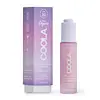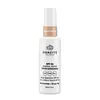COOLA Full Spectrum 360° Sun Silk Drops Organic Sunscreen SPF 30 Versus Odacité California SPF 50 Tinted Mineral Drops
What's inside
What's inside
 Key Ingredients
Key Ingredients

 Benefits
Benefits

 Concerns
Concerns

 Ingredients Side-by-side
Ingredients Side-by-side

Hyaluronic Acid
HumectantNelumbo Nucifera Flower Extract
Skin ConditioningButyl Methoxydibenzoylmethane 2%
UV AbsorberHomosalate 10%
Skin ConditioningEthylhexyl Salicylate 5%
UV AbsorberOctocrylene 6%
UV AbsorberAloe Barbadensis Leaf Extract
EmollientAnthemis Nobilis Flower Oil
MaskingButylene Glycol
HumectantButyloctyl Salicylate
Skin ConditioningCalcium Gluconate
HumectantCaprylic/Capric Triglyceride
MaskingCarthamus Tinctorius Seed Oil
MaskingCitrus Aurantium Amara Flower Extract
RefreshingCitrus Aurantium Amara Leaf/Twig Extract
Skin ConditioningDicaprylyl Carbonate
EmollientGlycerin
HumectantGlyceryl Stearate Se
EmulsifyingJasminum Sambac Leaf Cell Extract
MaskingNylon-12
Olea Europaea Fruit Oil
MaskingPlankton Extract
Skin ConditioningPropanediol
SolventSchinus Molle Extract
Skin ProtectingSimmondsia Chinensis Seed Oil
EmollientSodium Benzoate
MaskingSodium Hyaluronate
HumectantSodium Stearoyl Glutamate
CleansingTheobroma Cacao Seed Extract
AntioxidantTocopheryl Acetate
AntioxidantWater
Skin ConditioningXanthan Gum
EmulsifyingHyaluronic Acid, Nelumbo Nucifera Flower Extract, Butyl Methoxydibenzoylmethane 2%, Homosalate 10%, Ethylhexyl Salicylate 5%, Octocrylene 6%, Aloe Barbadensis Leaf Extract, Anthemis Nobilis Flower Oil, Butylene Glycol, Butyloctyl Salicylate, Calcium Gluconate, Caprylic/Capric Triglyceride, Carthamus Tinctorius Seed Oil, Citrus Aurantium Amara Flower Extract, Citrus Aurantium Amara Leaf/Twig Extract, Dicaprylyl Carbonate, Glycerin, Glyceryl Stearate Se, Jasminum Sambac Leaf Cell Extract, Nylon-12, Olea Europaea Fruit Oil, Plankton Extract, Propanediol, Schinus Molle Extract, Simmondsia Chinensis Seed Oil, Sodium Benzoate, Sodium Hyaluronate, Sodium Stearoyl Glutamate, Theobroma Cacao Seed Extract, Tocopheryl Acetate, Water, Xanthan Gum
Zinc Oxide 12%
Cosmetic ColorantWater
Skin ConditioningC12-15 Alkyl Benzoate
AntimicrobialCaprylic/Capric Triglyceride
MaskingJojoba Esters
EmollientPropanediol
SolventTridecyl Salicylate
Skin ConditioningPolyglyceryl-4 Diisostearate/Polyhydroxystearate/Sebacate
EmulsifyingMethylheptyl Isostearate
Skin ConditioningNiacinamide
SmoothingNylon-12
Methylpropanediol
SolventSilica
AbrasiveCoco-Caprylate
EmollientSodium Chloride
MaskingPolyglyceryl-2 Dipolyhydroxystearate
Skin ConditioningBisabolol
MaskingAllantoin
Skin ConditioningOryza Sativa Bran Extract
Skin ConditioningLecithin
EmollientCaprylyl Glycol
EmollientGlycerin
HumectantHelianthus Annuus Flower Extract
Skin ConditioningTetrasodium Glutamate Diacetate
Phenylpropanol
MaskingTocopherol
AntioxidantRosmarinus Officinalis Leaf Extract
AntimicrobialChamomilla Recutita Flower Extract
MaskingCalendula Officinalis Flower Extract
MaskingCamellia Sinensis Leaf Extract
AntimicrobialPotassium Sorbate
PreservativeSodium Benzoate
MaskingSodium Hydroxide
BufferingTitanium Dioxide
Cosmetic ColorantIron Oxides
Zinc Oxide 12%, Water, C12-15 Alkyl Benzoate, Caprylic/Capric Triglyceride, Jojoba Esters, Propanediol, Tridecyl Salicylate, Polyglyceryl-4 Diisostearate/Polyhydroxystearate/Sebacate, Methylheptyl Isostearate, Niacinamide, Nylon-12, Methylpropanediol, Silica, Coco-Caprylate, Sodium Chloride, Polyglyceryl-2 Dipolyhydroxystearate, Bisabolol, Allantoin, Oryza Sativa Bran Extract, Lecithin, Caprylyl Glycol, Glycerin, Helianthus Annuus Flower Extract, Tetrasodium Glutamate Diacetate, Phenylpropanol, Tocopherol, Rosmarinus Officinalis Leaf Extract, Chamomilla Recutita Flower Extract, Calendula Officinalis Flower Extract, Camellia Sinensis Leaf Extract, Potassium Sorbate, Sodium Benzoate, Sodium Hydroxide, Titanium Dioxide, Iron Oxides
 Reviews
Reviews

Ingredients Explained
These ingredients are found in both products.
Ingredients higher up in an ingredient list are typically present in a larger amount.
This ingredient is an emollient, solvent, and texture enhancer. It is considered a skin-softener by helping the skin prevent moisture loss.
It helps thicken a product's formula and makes it easier to spread by dissolving clumping compounds.
Caprylic Triglyceride is made by combining glycerin with coconut oil, forming a clear liquid.
While there is an assumption Caprylic Triglyceride can clog pores due to it being derived from coconut oil, there is no research supporting this.
Learn more about Caprylic/Capric TriglycerideGlycerin is already naturally found in your skin. It helps moisturize and protect your skin.
A study from 2016 found glycerin to be more effective as a humectant than AHAs and hyaluronic acid.
As a humectant, it helps the skin stay hydrated by pulling moisture to your skin. The low molecular weight of glycerin allows it to pull moisture into the deeper layers of your skin.
Hydrated skin improves your skin barrier; Your skin barrier helps protect against irritants and bacteria.
Glycerin has also been found to have antimicrobial and antiviral properties. Due to these properties, glycerin is often used in wound and burn treatments.
In cosmetics, glycerin is usually derived from plants such as soybean or palm. However, it can also be sourced from animals, such as tallow or animal fat.
This ingredient is organic, colorless, odorless, and non-toxic.
Glycerin is the name for this ingredient in American English. British English uses Glycerol/Glycerine.
Learn more about GlycerinNylon-12 is a polymer. It is derived from 12-aminododecanoic acid, an omega-amino fatty acid
According to a manufacturer, it is a talc substitute. Like talc, nylon-12 gives products a satin feel. The manufacturer also claims this ingredients does not block pores and has moderate oil absorption.
This ingredient may not be reef-safe.
Learn more about Nylon-12Propanediol is an all-star ingredient. It softens, hydrates, and smooths the skin.
It’s often used to:
Propanediol is not likely to cause sensitivity and considered safe to use. It is derived from corn or petroleum with a clear color and no scent.
Learn more about PropanediolSodium Benzoate is a preservative. It's used in both cosmetic and food products to inhibit the growth of mold and bacteria. It is typically produced synthetically.
Both the US FDA and EU Health Committee have approved the use of sodium benzoate. In the US, levels of 0.1% (of the total product) are allowed.
Sodium benzoate works as a preservative by inhibiting the growth of bacteria inside of cells. It prevents the cell from fermenting a type of sugar using an enzyme called phosphofructokinase.
It is the salt of benzoic acid. Foods containing sodium benzoate include soda, salad dressings, condiments, fruit juices, wines, and snack foods.
Studies for using ascorbic acid and sodium benzoate in cosmetics are lacking, especially in skincare routines with multiple steps.
We always recommend speaking with a professional, such as a dermatologist, if you have any concerns.
Learn more about Sodium BenzoateWater. It's the most common cosmetic ingredient of all. You'll usually see it at the top of ingredient lists, meaning that it makes up the largest part of the product.
So why is it so popular? Water most often acts as a solvent - this means that it helps dissolve other ingredients into the formulation.
You'll also recognize water as that liquid we all need to stay alive. If you see this, drink a glass of water. Stay hydrated!
Learn more about Water